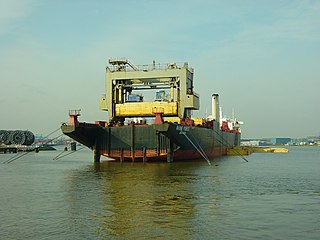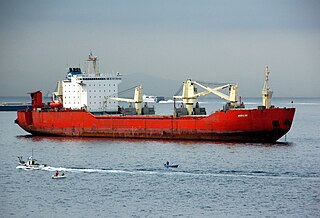
Open Hatch General Cargo, abbreviated (OHGC), is a ship designed to transport forest products, bulk cargos, unitized cargoes, project cargoes and containers.

Open Hatch General Cargo, abbreviated (OHGC), is a ship designed to transport forest products, bulk cargos, unitized cargoes, project cargoes and containers.
The vessel is typically fitted with two Gantry cranes for self-loading and unloading, with a typical SWL (safe working load) between 30 and 80 tons. Different equipment is connected to the gantry crane depending on cargo type as vacuum clamps for paper, unihook for unitised cargo, container frame and grab for bulk cargoes. Cargo holds are box shaped to fit containers and some holds can be equipped with tweendecks to improve flexibility of cargo mixture in same hold. Holds are typically equipped with dehumidifier for sensitive cargo. Cargo hatch covers for holds are opened and closed by mean of gantry crane. Space on those hatch covers can also be used to carry containers, lumber or project cargoes. [1]
Modern open hatch general cargo ships feature advanced designs to enhance efficiency and accommodate diverse cargo types. Gantry cranes with automated systems enable faster, safer loading and unloading, reducing turnaround time in ports. The box-shaped cargo holds allow seamless handling of containers, bulk, and breakbulk goods.
To meet international environmental standards, many vessels include ballast water treatment systems to prevent the spread of invasive species. Enhanced tweendeck configurations support cargo segregation and optimized weight distribution, while reinforced hatch covers accommodate heavy or oversized project cargo. Adjustable dehumidifier systems ensure safe transport of moisture-sensitive goods, making these ships versatile assets in global trade.

A container ship is a cargo ship that carries all of its load in truck-size intermodal containers, in a technique called containerization. Container ships are a common means of commercial intermodal freight transport and now carry most seagoing non-bulk cargo.

Intermodal freight transport involves the transportation of freight in an intermodal container or vehicle, using multiple modes of transportation, without any handling of the freight itself when changing modes. The method reduces cargo handling, and so improves security, reduces damage and loss, and allows freight to be transported faster. Reduced costs over road trucking is the key benefit for inter-continental use. This may be offset by reduced timings for road transport over shorter distances.

A dockworker is a waterfront manual laborer who loads and unloads ships.

A merchant ship, merchant vessel, trading vessel, or merchantman is a watercraft that transports cargo or carries passengers for hire. This is in contrast to pleasure craft, which are used for personal recreation, and naval ships, which are used for military purposes.

A bulk carrier or bulker is a merchant ship specially designed to transport unpackaged bulk cargo—such as grain, coal, ore, steel coils, and cement—in its cargo holds. Since the first specialized bulk carrier was built in 1852, economic forces have led to increased size and sophistication of these ships. Today's bulk carriers are specially designed to maximize capacity, safety, efficiency, and durability.

A container crane is a type of large dockside gantry crane found at container terminals for loading and unloading intermodal containers from container ships.

A dry bulk cargo barge is a barge designed to carry freight such as coal, ores, grain, sand or gravel, or similar materials. Barges are usually constructed of steel. They have an outer hull, and one or more internal holds. A rake barge has a bow shaped to cause less resistance when being pushed and is usually placed at the head of the tow. A box barge has no rake to the ends and is usually placed in the center and rear of the tow and can hold more cargo.

The lighter aboard ship (LASH) system refers to the practice of loading barges (lighters) aboard a bigger vessel for transport. It was developed in response to a need to transport lighters, a type of unpowered barge, between inland waterways separated by open seas. Lighters are typically towed or pushed around harbors, canals or rivers and cannot be relocated under their own power. The carrier ships are known variously as LASH carriers, barge carriers, kangaroo ships or lighter transport ships.
A ship's hold or cargo hold is a space for carrying cargo in a ship or airplane compartment.

A gantry crane is a crane built atop a gantry, which is a structure used to straddle an object or workspace. They can range from enormous "full" gantry cranes, capable of lifting some of the heaviest loads in the world, to small shop cranes, used for tasks such as lifting automobile engines out of vehicles. They are also called portal cranes, the "portal" being the empty space straddled by the gantry.

Handysize is a naval architecture term for smaller bulk carriers or oil tanker with deadweight of up to 50,000 tonnes, although there is no official definition in terms of exact tonnages. Handysize is also sometimes used to refer to the span of up to 60,000 tons, with the vessels above 35,000 tonnes referred to as Handymax or Supramax.

The Port of Haydarpaşa, also known as the Port of Haidar Pasha or the Port of Istanbul, is a general cargo seaport, ro-ro and container terminal, situated in Haydarpaşa, Istanbul, Turkey at the southern entrance to the Bosphorus, near Haydarpaşa Station. It is operated by the Turkish State Railways (TCDD) and serves a hinterland which includes the country's most industrialised areas.

In shipping, break-bulk, breakbulk, or break bulk cargo, also called general cargo, is goods that are stowed on board ships in individually counted units. Traditionally, the large numbers of items are recorded on distinct bills of lading that list them by different commodities. This is in contrast to cargo stowed in modern intermodal containers as well as bulk cargo, which goes directly, unpackaged and in large quantities, into a ship's hold(s), measured by volume or weight.
A berth is a designated location in a port or harbour used for mooring vessels when they are not at sea. Berths provide a vertical front which allows safe and secure mooring that can then facilitate the unloading or loading of cargo or people from vessels.
The MACS3 Loading Computer System is a computer controlled loading system for commercial vessels, developed by Navis Carrier & Vessel Solutions. Prior to October, 2017 it was offered by Interschalt maritime systems GmbH, and before 2007 - by Seacos Computersysteme & Software GmbH.
A cellular vessel is a container ship specially designed for the efficient storage of freight containers one on top of other with vertical bracings at the four corners. The majority of vessels operated by maritime carriers are fully cellular ships.

Lekki Deep Sea Port, is a multi-purpose, deep sea port in the Lagos Free Zone and is the only currently operating deep sea port in the country, having started full commercial operations in April 2023.

SA-15 is the project name for a series of icebreaking multipurpose cargo ships built in Finland for the Soviet Union in the 1980s. The ships, capable of independent operation in all prevailing arctic ice conditions, were the first merchant vessels designed for year-round operations in the Northern Sea Route. For this purpose they have hulls that resemble those of polar icebreakers and propulsion systems capable of withstanding ice loads.

Mundra Port is India's first private port, largest container port and largest commercial port, located on the northern shores of the Gulf of Kutch near Mundra, Kutch district, Gujarat. Formerly operated by Mundra Port and Special Economic Zone Limited (MPSEZ) owned by Adani Group, it was later expanded into Adani Ports & SEZ Limited (APSEZ) managing several ports. In FY 2020–21, Mundra Port handled 144.4 million tonnes of cargo. The port currently handles over 155 MT, which constitutes nearly 11 per cent of India’s maritime cargo. The port also handles nearly 33 per cent of India’s container traffic.

The Haldia Dock Complex (HDC) is a docking facility on the Hooghly River in Haldia, West Bengal, India. It is one of the two dock systems under the Syama Prasad Mookerjee Port, Kolkata, with the other being the Kolkata Dock System (KDS). The facility specializes in handling dry and liquid bulk cargo. It is located about 130 kilometres (81 mi) from the sandheads–deep sea area of the Bay of Bengal, 45 kilometres (28 mi) upstream from Pilotage Station at Sagar and 104 km downstream of Kolkata. In 1968, an oil jetty was commissioned at Haldia, and officially in 1977 the dock facility of Haldia started functioning.